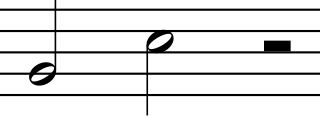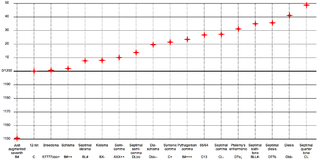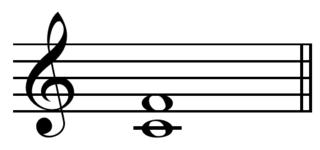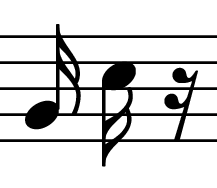
In music, counterpoint is the relationship between two or more musical lines which are harmonically interdependent yet independent in rhythm and melodic contour. It has been most commonly identified in the European classical tradition, strongly developing during the Renaissance and in much of the common practice period, especially in the Baroque period. The term originates from the Latin punctus contra punctum meaning "point against point", i.e. "note against note".

Music notation or musical notation is any system used to visually represent aurally perceived music played with instruments or sung by the human voice through the use of written, printed, or otherwise-produced symbols, including notation for durations of absence of sound such as rests.

A clef is a musical symbol used to indicate which notes are represented by the lines and spaces on a musical stave. Placing a clef on a stave assigns a particular pitch to one of the five lines, which defines the pitches on the remaining lines and spaces.
In Western musical notation, the staff (US) or stave (UK) is a set of five horizontal lines and four spaces that each represent a different musical pitch or in the case of a percussion staff, different percussion instruments. Appropriate music symbols, depending on the intended effect, are placed on the staff according to their corresponding pitch or function. Musical notes are placed by pitch, percussion notes are placed by instrument, and rests and other symbols are placed by convention.

In music, a half note (American) or minim (British) is a note played for half the duration of a whole note and twice the duration of a quarter note. It was given its Latin name because it was the shortest of the five note values used in early medieval music notation. Half notes are notated with a hollow oval notehead like a whole note and straight note stem with no flags like a quarter note. The half rest denotes a silence of the same duration. Half rests are drawn as filled-in rectangles sitting on top of the middle line of the musical staff, although in polyphonic music the rest may need to be moved to a different line or even a ledger line. As with all notes with stems, half notes are drawn with stems to the right of the notehead facing up when they are below the middle line of the staff. When they are on or above the middle line, they are drawn with stems on the left of the notehead facing down.

An eighth note (American) or a quaver (British) is a musical note played for one eighth the duration of a whole note (semibreve), hence the name. This amounts to twice the value of the sixteenth note (semiquaver). It is half the duration of a quarter note (crotchet), one quarter the duration of a half note (minim), one eighth the duration of a whole note (semibreve), one-sixteenth the duration of a double whole note (breve), and one thirty-second the duration of a longa. It is the equivalent of the fusa in mensural notation.

In modern musical notation and tuning, an enharmonic equivalent is a note, interval, or key signature that is equivalent to some other note, interval, or key signature but "spelled", or named differently. So, the enharmonic spelling of a written note, interval, or chord is an alternative way to write that note, interval, or chord. The term is derived from Latin enharmonicus, from Late Latin enarmonius, from Ancient Greek ἐναρμόνιος (enarmónios), from ἐν (en) and ἁρμονία (harmonía).

A fourth is a musical interval encompassing four staff positions in the music notation of Western culture, and a perfect fourth is the fourth spanning five semitones. For example, the ascending interval from C to the next F is a perfect fourth, because the note F is the fifth semitone above C, and there are four staff positions between C and F. Diminished and augmented fourths span the same number of staff positions, but consist of a different number of semitones.

In music, a thirty-second note (American) or demisemiquaver (British) is a note played for 1⁄32 of the duration of a whole note. It lasts half as long as a sixteenth note and twice as long as a sixty-fourth.
In music notation, a sixty-fourth note (American), or hemidemisemiquaver or semidemisemiquaver (British), sometimes called a half-thirty-second note, is a note played for half the duration of a thirty-second note, hence the name. It first occurs in the late 17th century and, apart from rare occurrences of hundred twenty-eighth notes (semihemidemisemiquavers) and two hundred fifty-sixth notes (demisemihemidemisemiquavers), it is the shortest value found in musical notation.
The numbered musical notation, is a cipher notation system used in China, and to some extent in Japan, Indonesia, Malaysia, Australia, Ireland, the United Kingdom, the United States and English-speaking Canada. It dates back to the system designed by Pierre Galin, known as Galin-Paris-Chevé system. It is also known as Ziffernsystem, meaning "number system" or "cipher system" in German.

In music notation, a note value indicates the relative duration of a note, using the texture or shape of the notehead, the presence or absence of a stem, and the presence or absence of flags/beams/hooks/tails. Unmodified note values are fractional powers of two, for example one, one-half, one fourth, etc.
A broken chord is a chord broken into a sequence of notes. A broken chord may repeat some of the notes from the chord and span one or more octaves.

Mensural notation is the musical notation system used for European vocal polyphonic music from the later part of the 13th century until about 1600. The term "mensural" refers to the ability of this system to describe precisely measured rhythmic durations in terms of numerical proportions between note values. Its modern name is inspired by the terminology of medieval theorists, who used terms like musica mensurata or cantus mensurabilis to refer to the rhythmically defined polyphonic music of their age, as opposed to musica plana or musica choralis, i.e., Gregorian plainchant. Mensural notation was employed principally for compositions in the tradition of vocal polyphony, whereas plainchant retained its own, older system of neume notation throughout the period. Besides these, some purely instrumental music could be written in various forms of instrument-specific tablature notation.

In musical notation, a beam is a horizontal or diagonal line used to connect multiple consecutive notes to indicate rhythmic grouping. Only eighth notes (quavers) or shorter can be beamed. The number of beams is equal to the number of flags that would be present on an unbeamed note. Beaming refers to the conventions and use of beams. A primary beam connects a note group unbroken, while a secondary beam is interrupted or partially broken.

The Stradella Bass System is a buttonboard layout equipped on the bass side of many accordions, which uses columns of buttons arranged in a circle of fifths; this places the principal major chords of a key in three adjacent columns.

In music, a 1/16, sixteenth note (American) or semiquaver (British) is a note played for half the duration of an eighth note (quaver), hence the names. It is the equivalent of the semifusa in mensural notation, first found in 15th-century notation.
Excursions, Op. 20, is the first published solo piano piece by Samuel Barber. Barber himself explains:
These are ‘Excursions’ in small classical forms into regional American idioms. Their rhythmic characteristics, as well as their source in folk material and their scoring, reminiscent of local instruments are easily recognized.
Traditional sub-Saharan African harmony is a music theory of harmony in Sub-Saharan Africa music based on the principles of homophonic parallelism, homophonic polyphony, counter melody and ostinato-variation. Polyphony is common in African music and heterophony is a common technique as well. Although these principles of traditional African music are of Pan-African validity, the degree to which they are used in one area over another varies. Specific techniques that used to generate harmony in Africa are the "span process", "pedal notes", "Rhythmic harmony", "harmony by imitation", and "scalar clusters".
Abbreviations in music are of two kinds, namely, abbreviations of terms related to musical expression, and the true musical abbreviations by the help of which certain passages, chords, etc., may be notated in a shortened form, to the greater convenience of both composer and performer. Abbreviations of the first kind are like most abbreviations in language; they consist for the most part of the initial letter or first syllable of the word employed—as for instance, p or f for the dynamic markings piano and forte, cresc. for crescendo, Ob. for oboe, Fag. for bassoon. This article is about abbreviations used in music notation. For abbreviations of terms related to musical expression and music in general, see Glossary of musical terminology.















